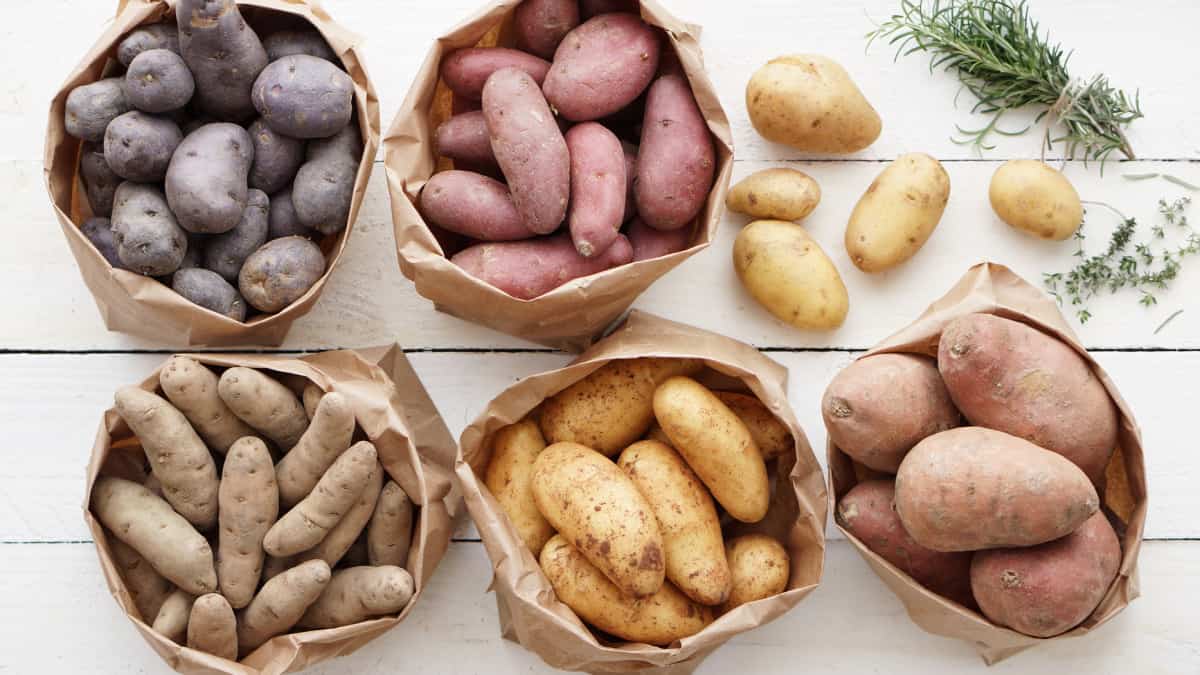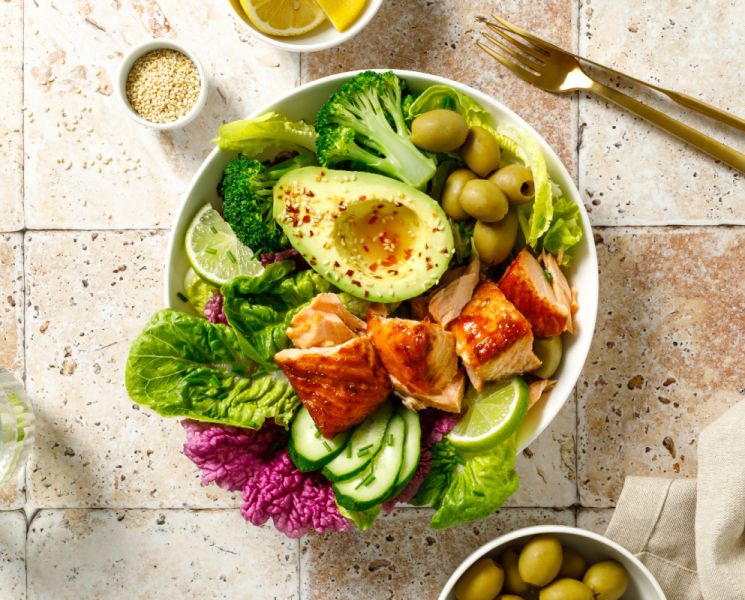Here are the five most common types of potatoes, their nutritional value, and how to use each of them to their full potential.
Did you know there are over 200 types of potatoes in the United States alone? This versatile root vegetable has more nutrition and culinary uses than we give it credit for. What are the differences in russet potatoes vs. red potatoes? Which choice is best for the dish you plan to make? Here are key things to know.
5 Common Potatoes to Choose From
There are 5 potato varieties you likely often seen at the grocery store or farmers markets near you. These include:
- Russet Potatoes
- Red Potatoes
- Purple Potatoes
- Yellow Potatoes
- White Potatoes
Keep reading for more about how to use each kind, their flavor profiles, and nutrition information.
1. Russet Potatoes
Arguably one of the most common and well-used potato types, russet potatoes are a staple ingredient in kitchens across the country. Russet potatoes come in a number of varieties, such as Burbank, Goldrush, and Centennial.
Russets have a mild, earthy flavor, and a light and dry texture. They work best for baking and frying. This creates a crispy exterior, and light and fluffy interior. This type of potato is excellent baked, sliced into homemade french fries, or roasted in wedges. They have a hearty light-brown skin and pale yellow or white flesh inside.
Nutrition of Russet Potatoes
They are naturally sodium and cholesterol free, high in vitamin C, and a medium Russet potato actually contains more potassium than a banana. (Here are 4 other foods that are excellent sources of potassium)
- Calories: 168
- Carbohydrates: 39g
- Fiber: 3g
- Protein: 5g
- Fat: 0g
- Iron: 2mg
- Potassium: 888mg
- Vitamin A: 2IU
- Vitamin C: 12mg
- Vitamin K: 3.83 µg
2. Red Potatoes
Many people wonder, “are red potatoes healthy?” In addition to giving these potatoes their namesake, the red skin of this variety provides them with a different nutrition profile as well. Since it is thin and delicate, the skin does not affect the flavor or texture of a dish as much as other varieties may.
Red potatoes have a smooth, thin, and red skin with a white interior flesh. They have a waxy, creamy, and subtly sweet flavor, and maintain a firm texture when cooked. This makes them ideal for use in potato salads and soups, as well as mashed or roasted. Some of the most common varieties of red potatoes includes Chieftain, Norland, and Ruby.
Nutrition of Red Potatoes
The skin holds most of the potatoes fiber, and as compared to russet potatoes, red potatoes are lower in carbohydrates and calories, and higher in vitamin K and niacin.
- Calories: 149
- Carbohydrates: 34g
- Fiber: 4g
- Protein: 4g
- Fat: 0g
- Iron: 2mg
- Potassium: 969mg
- Vitamin A: 15 IU
- Vitamin C: 18 mg
- Vitamin K: 6 µg
Red Potato Recipe
Nutritionists eat potato salad too! Find out what other dishes they really eat at a BBQ.
3. Purple Potatoes
Purple potatoes have a mild, slightly nutty flavor and a firm texture. Their color is preserved best by microwave cooking, but can also be enjoyed by baking or steaming. The flavor profile of purple potatoes goes well with green salads. They also pair well with other varieties of potatoes such as white and red, which makes their color truly pop. The most popular varieties of purple potatoes include Purple Majesty, Adirondack Blue, and Purple Peruvian.
Nutrition of Purple Potatoes
Their signature dark-hued flesh is not only eye-catching, but is full of added nutrition as well. Purple potatoes’ nutrition is worth noting! They contain the same nutrients as russet potatoes (such as fiber, potassium, and B vitamins), but what sets them apart is their antioxidant content.
Their bright purple color is credited to anthocyanins, the same antioxidants found in other purple-hued foods such as grapes and red wine. This gives purple potatoes four times as many antioxidants as a russet potato, and an easy way to add color to any dish.
- Calories: 110
- Carbohydrates: 26g
- Fiber: 4g
- Protein: 2g
- Fat: 0g
- Iron: 1mg
- Potassium: 438mg
- Vitamin A: 36900 IU
- Vitamin C: 3 mg
Purple Potato Recipe
Discover the culinary power of purple potatoes in this Purple Power Bowl with Prunes & Spiced Vinaigrette Dressing.

4. Yellow Potatoes
Yellow potatoes have received extra special attention from both consumers and chefs for their smooth texture and buttery taste. Some of the most popular varieties of yellow potatoes includes Yellow Finn, and Agata.
As their name implies, yellow potatoes have a golden flesh with a light tan skin. They have a moist, velvety texture with a slightly sweet and buttery flavor that can easily be transformed into creamy mashed potatoes or roasted into coins. Their natural, more decadent flavor allows for the use of less butter in recipes, making them a lighter choice without a sacrifice in flavor.
Are Yellow Potatoes the Same as Yukon Gold?
Yukon Gold and yellow potatoes are often used interchangeably. However, Yukon Gold potatoes are a cross between yellow and white potatoes.
Nutrition of Yellow Potatoes
Like most types of potatoes, yellow are an excellent source of energy-boosting carbohydrates, vitamin C, and potassium, but are also a good source of vitamin B6, thiamin, and dietary fiber.
- Calories: 110
- Carbohydrates: 26g
- Fiber: 2g
- Protein: 3g
- Fat: 0g
- Iron: 1mg
- Potassium: 620mg
- Vitamin A: 0IU
- Vitamin C: 26.9 mg
Yellow Potato Recipe
Step up your potato salad game with this Warm Potato, Leek, and Lentil Salad with Citrus and Herbs.
5. White Potatoes
White potatoes are often thought of as a less nutritious option when compared to other vegetables. While they tend to be higher in carbohydrates and lower in fiber than non-starchy veggies (such as leafy greens, peppers, and asparagus), white potatoes are still a nutritious, and satisfying food with an array of culinary possibilities. When compared to sweet potatoes, white potatoes are slightly higher in protein, potassium, and magnesium, and lower in sugar.
White potatoes have a delicate, light golden skin with a bright white flesh. They tend to hold their shape when cooked, and can withstand grilling and frying applications. Since their skin is thin and delicate, white potatoes can be mashed with their skin-on without significantly impacting their flavor or texture. Some of the most common varieties of white potatoes include White Rose, Cascade, and Kennebec.
Nutrition of White Potatoes
- Calories: 174
- Carbohydrates: 33g
- Fiber: 5g
- Protein: 4g
- Fat: 0g
- Iron: 1mg
- Potassium: 867 mg
- Vitamin A: 17 IU
- Vitamin C: 20mg
- Vitamin K: 3µg
White Potato Recipe
Still love sweet potatoes? Try this Sweet Potato Turmeric Soup for a quick & easy lunch.
Final Dietitian Insights on Different Types of Potatoes
In the world of potatoes, variety brings the fun into play. From the creamy textures of Yukon Golds, to the rustic appeal of Russets, and the vibrant colors of sweet potatoes, each type offers a different experience. Whether you’re mashing, roasting, or frying, these diverse spuds bring a delightful twist to your meals. So, don’t hesitate to explore the potato varieties available and elevate your culinary adventures with the perfect potato for every occasion.
This post has been updated since it’s last publish date in 2019.





